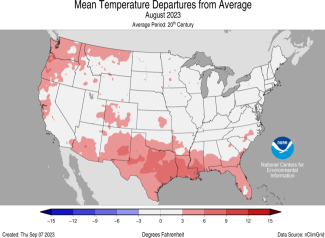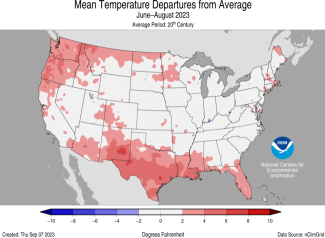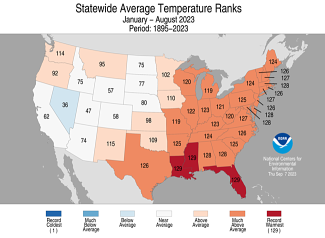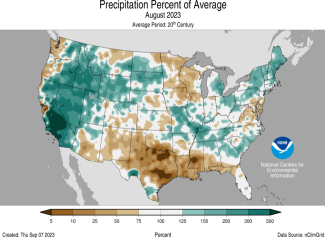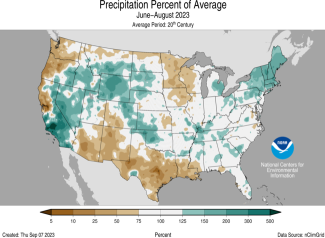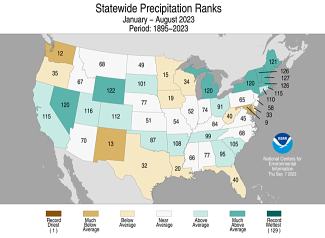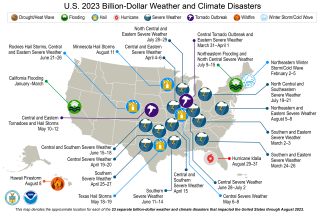A record number of billion-dollar events occurred in 2023; much of the Gulf Coast experienced record warmth during August

Key Points:
- A total of 23 separate billion-dollar weather and climate disasters have been confirmed this year—the most events on record during a calendar year.
- Much of the eastern U.S. has been consistently warmer than average during 2023 with 28 states experiencing a top-10 warmest January–August.
- Near-record to record-warm temperatures were observed along the Gulf of Mexico this month. In this region, a total of 290 counties had their warmest August on record.
- August 2023 was the ninth-warmest August on record for the nation, while precipitation ranked in the middle third of the historical record.
Other Highlights:
Temperature
The average temperature of the contiguous U.S. in August was 74.4°F, 2.3°F above average, ranking ninth warmest in the 129-year record. Generally, August temperatures were above average across much of the contiguous U.S., with below-normal temperatures in parts of the Great Lakes, Ohio River Valley, Northeast and southern California. Louisiana, Mississippi and Florida ranked warmest on record for August while Texas ranked second warmest on record. An additional seven states ranked among their top-10 warmest August on record.
The Alaska statewide August temperature was 53.3°F, 3.8°F above the long-term average, ranking third warmest in the 99-year period of record for the state. Above-normal temperatures were observed across most of the state with record-warm temperatures observed in parts of the Southeast Interior of the state.
The meteorological summer (June–August) average temperature for the contiguous U.S. was 73.0°F, 1.6°F above average, ranking 15th warmest on record. Temperatures were above average across much of the West and in parts of the Upper Midwest, Southern Plains, Northeast and along the Gulf of Mexico and East Coast. Temperatures were below average in parts of the west-central Plains, Ohio Valley and Southeast. Louisiana ranked warmest on record, while Texas and Florida each ranked second warmest for this summer season. Four additional states ranked among their top-10 warmest on record for this period.
The Alaska summer temperature was 53.1°F, 2.6°F above the long-term average, ranking eighth warmest on the record for the state. Temperatures were above average across most of the state of Alaska while some parts of the Southwest saw near-average summer temperatures.
For the January–August period, the average contiguous U.S. temperature was 55.6°F, 1.8°F above average, ranking 13th warmest on record for this period. Temperatures were above average from the southern Plains to the East Coast and along parts of the Northern Tier, with near- to below-average temperatures from the northern Plains to the West Coast. Louisiana, Mississippi and Florida ranked warmest on record while Massachusetts, Delaware, Maryland, Alabama and Georgia each ranked second warmest for the January–August period. An additional 20 states had a top-10 warmest year-to-date period. No state experienced a top-10 coldest event for this eight-month period.
The Alaska January–August temperature was 30.8°F, 2.0°F above the long-term average, ranking in the warmest third of the historical record for the state. Much of the state was above normal for the eight-month period while temperatures were near average across much of the Interior and West Coast.
Precipitation
August precipitation for the contiguous U.S. was 2.74 inches, 0.12 inch above average, ranking in the middle third of the historical record. Precipitation was below average from southern Arizona to Florida and in parts of the Northwest, western Great Lakes, central Plains and Mid-Atlantic. Precipitation was above average across much of the West, eastern Great Lakes and Northeast, and in parts of the northern Plains, Ohio Valley and Southeast. California and Nevada each had their second-wettest August on record, while eight additional states had a top-10 wettest August on record. On the dry side, Louisiana ranked driest on record for the month with two additional states ranking among their top-10 driest August on record.
Across the state of Alaska, the average monthly precipitation was 4.89 inches, ranking in the wettest third of the historical record. Conditions were wetter than average across parts of the Interior, Southwest and south-central Alaska during this August. Much of the North Slope, West Coast, Southeast and Panhandle were near normal, while below-normal precipitation was observed in parts of the Aleutians during the month.
The U.S. summer precipitation total was 8.35 inches, 0.03 inch above average, ranking in the middle third of the June–August record. Precipitation was above average across much of California, the interior West and Northeast, and in parts of the central to northern Plains, Ohio Valley and Southeast. Summer precipitation was below average in parts of the Northwest, Southwest, southern Plains, Upper Midwest, Mid-Atlantic and Southeast. New Mexico and Louisiana each ranked third driest with four additional states ranking among their top-10 driest summer season on record. Conversely, Wyoming, Vermont and New Hampshire each ranked wettest on record, while five additional states ranked among their top-10 wettest during the June–August period.
For summer season precipitation, Alaska ranked in the wettest third of the record with wetter-than-average conditions observed across most of the state. Near-normal precipitation was observed in parts of the Southeast and Aleutians this season. Below-normal precipitation occurred in parts of the Southeast Interior and Alaska Panhandle during this period.
The January–August precipitation total for the contiguous U.S. was 21.19 inches, 0.48 inch above average, ranking in the middle third of the 129-year record. Precipitation was near to above average from California to the western Great Plains, in the Northeast and in parts of the southern Mississippi Valley, northern Great Lakes and Southeast. New Hampshire had its third wettest year-to-date period on record while seven additional states ranked among their top-10 wettest for this period. Conversely, precipitation was below average across parts of the Northwest, Southwest, eastern Plains, upper and central Mississippi Valley, Mid-Atlantic and along parts of the Gulf during the January–August period. Maryland had its ninth-driest January–August on record.
The January–August precipitation ranked 15th wettest in the 99-year record for Alaska, with above-average precipitation observed across much of the state. Near- to below-normal precipitation was observed in parts of Southeast Interior, Panhandle and Aleutians during this period.
Billion-Dollar Disasters
Eight new billion-dollar weather and climate disasters were confirmed this month including: Hurricane Idalia, the Hawaii Firestorm, the mid-July Northeast flooding and North Central Severe Weather, the Minnesota Hail Storms on August 11 and several other severe storm events that occurred in July.
There have been 23 confirmed weather and climate disaster events this year, each with losses exceeding $1 billion. These disasters consisted of 18 severe storm events, two flooding events, one tropical cyclone, one winter storm and one wildfire event. For this year-to-date period, the first eight months of 2023 rank highest for disaster count, ahead of 2020 with 16 disasters. The total cost of these events exceeds $57.6 billion, and they have resulted in 253 direct and indirect fatalities.
The U.S. has sustained 371 separate weather and climate disasters since 1980 where overall damages/costs reached or exceeded $1 billion (including CPI adjustment to 2023). The total cost of these 371 events exceeds $2.615 trillion.
Other Notable Events
A series of heat waves brought record-breaking temperatures to portions of the U.S. during August:
- August was the warmest month on record for Louisiana and Florida by nearly 1.5°F, while Mississippi was record warmest by nearly 0.5°F.
- A total of 301 counties each had their warmest August on record while an additional 441 counties ranked in the top-10 warmest for the month. There are 3,143 counties in the U.S.
- On August 24, temperatures in Chicago soared to 100°F—the first 100°F temperature since July 6, 2012—with a 120°F heat index, the highest ever recorded at Chicago’s official climate observation site.
- Phoenix, Arizona had their all-time warmest summer on record this year, with an average summer temperature of 97.0°F—breaking the previous record of 96.7°F set in 2020.
- San Juan, Puerto Rico had its hottest August on record, breaking the previous record from 1980.
Several notable tropical cyclones impacted portions of the U.S. in August:
- On August 8, winds from Hurricane Dora exacerbated a wildfire on the island of Maui, Hawaii, making it the deadliest wildfire in the U.S. in over a century.
- On August 18, the first-ever tropical storm watch was issued for southern California as remnants of Hurricane Hilary brought record-breaking rainfall and flooding to parts of the Southwest.
- On August 22, Tropical Storm Harold brought strong winds and heavy rains to parts of the southern Plains.
- On August 30, Hurricane Idalia made landfall in the Big Bend region of Florida as a Category 3 hurricane. This is the strongest hurricane to hit the region in more than 125 years.
Drought
According to the August 29 U.S. Drought Monitor report, about 34.3% of the contiguous U.S. was in drought, up about 6.2% from the beginning of August. Moderate to exceptional drought was widespread across much of the Great Plains, with moderate to extreme drought along the Northern Tier and Southwest. Moderate to severe drought was present in parts of the Mid-Atlantic, Florida and Hawaii as well as moderate drought in parts of the Michigan, Northeast, Southeast and Puerto Rico.
Drought conditions expanded or intensified along the Northern Tier, Upper Midwest, Southwest, southern Plains, Mid-Atlantic, Southeast and Hawaii this month. Drought contracted or was reduced in intensity across portions of the central Plains, Great Lakes, Ohio Valley, Northeast, Alaska and Puerto Rico.
Monthly Outlook
According to the August 30 One-Month Outlook from the Climate Prediction Center, much of the contiguous U.S. and parts of northern, eastern and southern Alaska favor above-normal monthly average temperatures in September, with the greatest odds in the southern Plains. The best chances for below-normal temperatures are forecast for parts of western Alaska. Portions of the Northwest, Southwest and much of Alaska are favored to see above-normal monthly total precipitation while below-normal precipitation is most likely to occur from south-central U.S. to the Great Lakes, as well as parts of the Alaska Panhandle. Drought improvement or removal is forecast in parts of the western Southwest, Southeast and Puerto Rico, while persistence is more likely across the Northern Tier and from the eastern Southwest to the Lower Mississippi Valley, and in parts of the central and northern Plains, Northeast, Mid-Atlantic and Hawaii. Drought development is likely across much of the central U.S. in parts of the Lower Mississippi Valley.
According to the One-Month Outlook issued on September 1 from the National Interagency Fire Center, Hawaii and northern portions of the West Coast as well as the Upper Midwest, southern Plains, Lower Mississippi Valley and Mid-Atlantic have above-normal significant wildland fire potential during September, while parts of southern California are expected to have below-normal potential for the month.
This monthly summary from NOAA’s National Centers for Environmental Information is part of the suite of climate services NOAA provides to government, business, academia and the public to support informed decision-making. For more detailed climate information, check out our comprehensive August 2023 U.S. Climate Report scheduled for release on September 14, 2023. For additional information on the statistics provided here, visit the Climate at a Glance and National Maps webpages.

